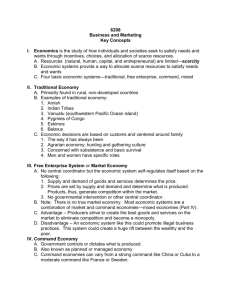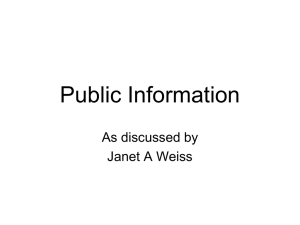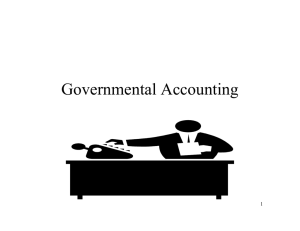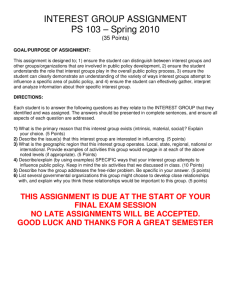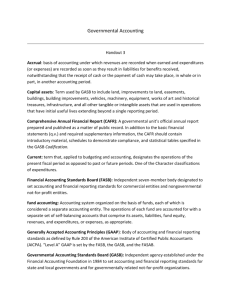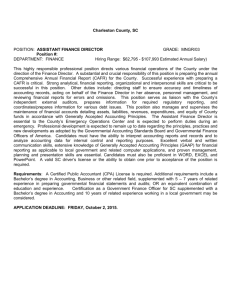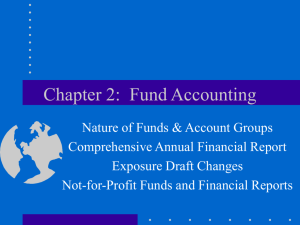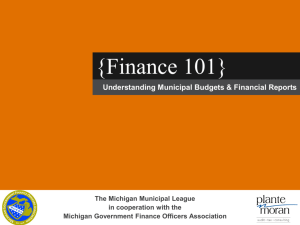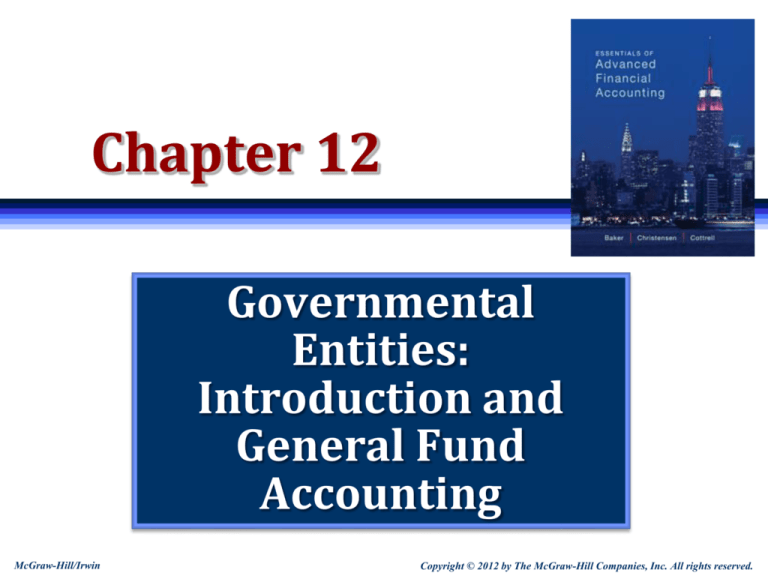
Chapter 12
Governmental
Entities:
Introduction and
General Fund
Accounting
McGraw-Hill/Irwin
Copyright © 2012 by The McGraw-Hill Companies, Inc. All rights reserved.
Learning Objective 1
Understand and explain the
basic differences between
governmental and private
sector accounting.
12-2
Overview
Governmental entities have operating
objectives different from those of commercial
entities.
As a result, governmental accounting is
different from accounting for commercial
enterprises.
12-3
Overview
Nature of governmental entities
1.
Collect resources and make expenditures to fulfil
societal needs
2.
Absence of profit motive except for some
activities
3.
Have legal authorization for their existence,
conduct revenue-raising through the power of
taxation, and have mandated expenditures they
must make to provide their services
4.
Control mechanism – Use of comprehensive
budgetary accounting
12-4
Overview
Nature of governmental entities
5.
Accountability for the flow of financial resources
is a chief objective
6.
Typically are required to establish separate
funds to carry out various missions; each fund is
an independent accounting and fiscal entity
7.
Many fund entities do not record fixed assets or
long-term debt in their funds
8.
An important objective of governmental
financial reporting is accountability
12-5
History of Governmental Accounting
History
Before 1934, directed by the Municipal Finance
Officers Association (MFOA)
In 1934, the first statement on local
governmental accounting published
In 1968, Governmental Accounting, Auditing,
and Financial Reporting (GAAFR) was published
The GAAFR is periodically updated to include the
most recent governmental reporting standards
12-6
History of Governmental Accounting
History
1974 –The American Institute of Certified Public
Accountants (AICPA) published an industry
audit guide, in which it stated that “except as
modified in this guide, they [GAAFR] constitute
generally accepted accounting principles”
March 1979 – The National Council on
Governmental Accounting (NCGA) issued its
Statement No. 1, “Governmental Accounting and
Financial Reporting Principles” (NCGA 1)
12-7
History of Governmental Accounting
History
1984 – Governmental Accounting Standards
Board (GASB) established
GASB Statement No. 1
The GASB stated that all NCGA statements and
interpretations issued and in effect on that date were
accepted as generally accepted accounting principles
for governmental accounting
GASB Statement No. 34
Established government-wide financial statements to
be prepared on the accrual basis of accounting and an
array of fund-based financial statements
12-8
History of Governmental Accounting
History
The GASB continues to issue new standards to
meet the information needs of users of the
financial reports of governmental units.
Accounting for governmental entities is given
the general name of fund accounting.
12-9
The Governmental Accounting Standards Board
(GASB)
GASB
Created in 1984
A sister organization to the FASB
Establishes GAAP for state and local units
No authority to establish GAAP for the federal
government
Seven members—simple majority vote needed
(4 votes)
12-10
GAAFR: “The Blue Book”
“Governmental Accounting, Auditing,
and Financial Reporting”
Published by the Government
Finance Officers Association (GFOA).
Neither prescribes nor
authoritatively interprets GAAP for
governmental units.
Provides detailed guidance (many
examples) for applying
governmental GAAP.
Widely used by governmental units.
12-11
Practice Quiz Question #1
Which of the following statements is correct?
a. The GASB is responsible to set standards
for governmental units and not-for-profit
entities.
b. The FASB was created in 1972 and sets
standards for governmental units.
c. The Blue Book contains financial
accounting standards for privately held
governmental agencies and companies.
d. The GASB is responsible for setting
standards for state and local governments
but not the federal government.
12-12
Practice Quiz Question #1
Which of the following statements is correct?
a. The GASB is responsible to set standards
for governmental units and not-for-profit
entities.
b. The FASB was created in 1972 and sets
standards for governmental units.
c. The Blue Book contains financial
accounting standards for privately held
governmental agencies and companies.
d. The GASB is responsible for setting
standards for state and local governments
but not the federal government.
12-13
Learning Objective 2
Understand and explain
major concepts of
governmental accounting.
12-14
Major Concepts of Governmental Accounting
Elements of a Statement of Financial Condition
1.
Assets are resources with present service capacity that
the entity presently controls.
2.
Liabilities are present obligations to sacrifice resources
that the entity has little or no discretion to avoid.
3.
A deferred outflow of resources is a consumption of net
assets that is applicable to a future reporting period.
4.
A deferred inflow of resources is an acquisition of net
assets that is applicable to a future reporting period.
5.
Net position is the residual of all other elements
presented in a statement of financial condition.
12-15
Major Concepts of Governmental Accounting
Elements of a the resource flows statements
1.
An outflow of resources is a consumption of net assets
that is applicable to the current reporting period
2.
An inflow of resources is an acquisition of net assets
that is applicable to the current reporting period
12-16
Major Concepts of Governmental Accounting
Expendability of resources versus capital
maintenance objectives
Commercial Enterprises
Government Entities
Measurement focus
The flow of all economic
resources
Changes in current financial
resources available to
provide services to the
public in accordance with the
budget
Method of
accounting
Accrual method
Modified accrual method
Balance sheet
Contains both current and
noncurrent assets and
liabilities, and the change in
retained earnings reflects
the company’s ability to
maintain its capital
investment
Reports only current assets,
current liabilities, and a fund
balance
12-17
Practice Quiz Question #2
Which of the following statements is true?
a. Governmental units use the modified
accrual basis of accounting and focus on
the flow of all economic resources.
b. Commercial enterprises use the modified
accrual basis of accounting and focus on
the flow of all economic resources.
c. The balance sheets of governmental units
contain long-term assets and liabilities.
d. The balance sheets of commercial entities
contain a fund balance.
12-18
Practice Quiz Question #2
Which of the following statements is true?
a. Governmental units use the modified
accrual basis of accounting and focus on
the flow of all economic resources.
b. Commercial enterprises use the modified
accrual basis of accounting and focus on
the flow of all economic resources.
c. The balance sheets of governmental units
contain long-term assets and liabilities.
d. The balance sheets of commercial entities
contain a fund balance.
12-19
Learning Objective 3
Understand and explain the
differences between the
various governmental fund
types.
12-20
The Nature & Diversity of Governmental Activities
The operations of governmental entities are
classified into three categories:
Governmental—these activities do not
resemble commercial activities.
Proprietary—these activities resemble
commercial activities. Can measure profitability
or capital maintenance.
Fiduciary—holding and managing assets owned
by others (e.g., pension assets).
12-21
Use of Fund Accounting
Fund Accounting
Accounting for certain activities separately from
all other operations.
Fund definition: A fiscal and accounting entity
with a self-balancing set of accounts (like a
branch or a division of a commercial entity).
The General Fund: The main and largest
fund—records most routine transactions.
The difference between a fund’s assets and
liabilities is called:
Government and
Fiduciary-type Funds
Fund Balance
Proprietary Funds
Net Assets
12-22
Major Concepts of Governmental Accounting
Three Types of Funds
Governmental Funds
Proprietary Funds
Used to provide basic governmental services to the
public
Each entity creates only one general fund, but it may
create more than one of each of the other types of
funds
The objective is to recover the unit’s costs through
user charges
Fiduciary Funds
12-23
Major Concepts : Types of Funds
Governmental Funds
General Fund: Accounts for all activities not
required to be accounted for in another fund.
Special Revenue Fund: A clone of the General
Fund.
Capital Projects Funds
Debt Service Funds
Permanent Funds
12-24
Major Concepts : Types of Funds
Proprietary Funds
Enterprise Funds:
Provides services primarily to nongovernmental
users
Examples: City-owned utilities or recreational
facilities
Internal Service Funds:
Provides services solely to governmental
departments.
12-25
Major Concepts : Types of Funds
Fiduciary Funds
Trust Funds
Pension (and similar) Trust Funds
Investment Trust Funds
Private-Purpose Trust Funds (these activities
do not benefit the government unit)
Agency Funds
12-26
Major Concepts of Governmental Accounting
Governmental Fund Types
General fund
Accounts for all financial resources except for those
accounted for in another fund. Includes transactions
for general governmental services provided by the
executive, legislative, and judicial operations of the
governmental entity.
Special revenue
fund
Accounts for the proceeds of specific revenue sources
that are restricted for specified purposes.
Capital projects
fund
Accounts for financial resources for the acquisition or
construction of major capital facilities that benefit
many citizens, such as parks and municipal buildings.
Accounts for the accumulation of resources for, and the
payment of, general long-term debt principal and
interest.
Debt service fund
Permanent fund
Accounts for resources that are restricted such that
only earnings, but not principal, may be used in support
of governmental programs that benefit the government
or its citizenry.
12-27
Major Concepts of Governmental Accounting
Proprietary Fund Types
Enterprise fund
Internal service fund
Accounts for operations of governmental units that
charge for services provided to the general public.
Accounts for the financing of goods or services provided
by one department or agency to other departments or
agencies of the governmental unit. Services are offered
only to governmental agencies.
Fiduciary Fund Types and Similar Component Units
Pension (and other
employee benefit)
trust fund
Investment trust fund
Private-purpose trust
fund
Agency fund
Accounts for resources required to be held in trust for
the members and beneficiaries of pension plans, other
post-employment benefit plans, or other EBPs.
Accounts for the external portion of investment pools
reported by the sponsoring government.
Accounts for all other trust arrangements under which
the fund’s resources are to be used to benefit specific
individuals, private organizations, or other
governments.
Accounts for assets held by a governmental unit in an
agency capacity for employees or for other
governmental units.
12-28
Practice Quiz Question #3
The three major categories of
governmental funds are:
a. Governmental, commercial, and
proprietary.
b. Governmental, trust, and fiduciary.
c. Enterprise, proprietary, and fiduciary .
d. Governmental, proprietary, and
fiduciary.
e. Governmental Service, proprietary,
and commercial
12-29
Practice Quiz Question #3
The three major categories of
governmental funds are:
a. Governmental, commercial, and
proprietary.
b. Governmental, trust, and fiduciary.
c. Enterprise, proprietary, and fiduciary .
d. Governmental, proprietary, and
fiduciary.
e. Governmental Service, proprietary,
and commercial
12-30
Learning Objective 4
Understand and explain basic
concepts for financial reporting
in governmental
accounting.
12-31
Financial Reporting of Governmental Entities
Governmental funds – financial
statements
Balance sheet
Statement of revenues, expenditures and
changes in fund balance
The five governmental funds use the current
financial resources measurement focus
12-32
Fund Accounting
Specific General Ledger Accounts Used
defined by GASB 54:
Government and
Fiduciary-type
Funds
Fund Balance
Non-spendable
Spendable:
• Restricted
• Limited
• Assigned
• Unassigned
Proprietary Funds
Net Assets
Restricted
Unrestricted
12-33
Financial Reporting of Governmental Entities
Balance Sheet for Governmental Funds
Assets (financial resources available for current use;
presented in order of liquidity)
Total Assets
Liabilities and Fund Balances:
Liabilities (due and expected to be paid from current
financial resources; presented in order of due date)
Fund Balances
Nonspendable
Spendable:
Restricted
Limited
Assigned
Unassigned
Total Liabilities and Fund Balances
$X,XXX
$X,XXX
$ XXX
$ XX
XX
XX
XX
XX
XX
$X,XXX
12-34
Financial Reporting of Governmental Entities
Statement of revenues, expenditures, and
changes in fund balance
Often called the operating statement of the
governmental funds
Statement of Revenues, Expenditures, and Changes in Fund Balance
Revenues (recognized when both measurable and available; presented
by source of revenue)
$XX,XXX
Expenditures (approved decreases in net financial resources; presented
by function and character)
X,XXX
Excess of Revenues over Expenditures
$
XXX
Other Financing Sources or Uses (other increases or decreases in net
financial resources available, such as bond issue proceeds and interfund
transfers)
XX
Special Items and Extraordinary Items
(X)
Net Change in Fund Balance
$
XX
Fund Balance—Beginning
XXX
Fund Balance—Ending (reconciles to total fund balance on balance sheet) $
XXX
12-35
Practice Quiz Question #4
Which of the following is true?
a. The operating statements of governmental
entities focus on revenues and expenses.
b. The balance sheets of governmental entities
focus on the normal accounting equation:
Assets – Liabilities = Owner’s Equity.
c. The operating statements of governmental
entities focus on revenues and liabilities.
d. The balance sheets of governmental entities
focus a modified accounting equation:
Assets – Liabilities = Fund Balance.
e. All governmental fund balances are
spendable.
12-36
Practice Quiz Question #4
Which of the following is true?
a. The operating statements of governmental
entities focus on revenues and expenses.
b. The balance sheets of governmental entities
focus on the normal accounting equation:
Assets – Liabilities = Owner’s Equity.
c. The operating statements of governmental
entities focus on revenues and liabilities.
d. The balance sheets of governmental entities
focus a modified accounting equation:
Assets – Liabilities = Fund Balance.
e. All governmental fund balances are
spendable.
12-37
Learning Objective 5
Understand and explain the
basic differences in the
measurement focus and basis
of accounting between
governmental and private sector
accounting.
12-38

